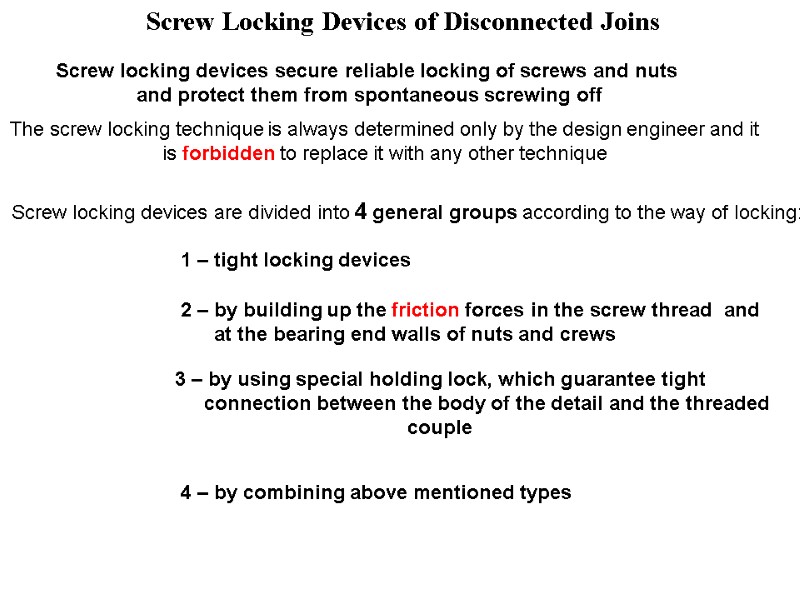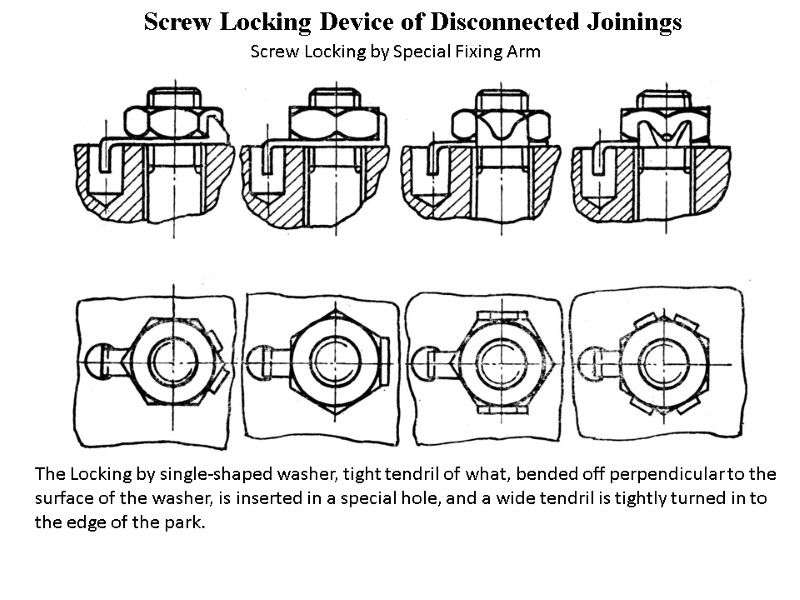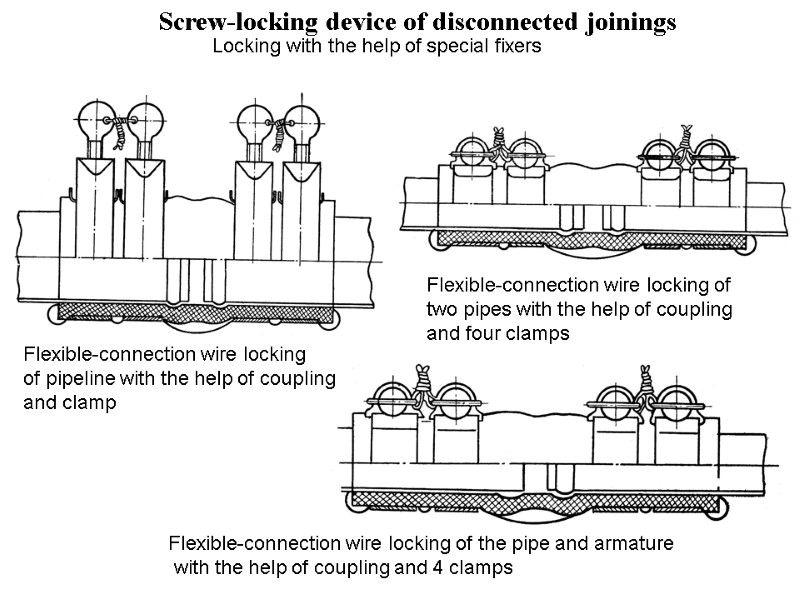Screw Locking Devices of Disconnected Joins Screw locking
























9346-00-screw_ld.ppt
- Количество слайдов: 23
 Screw Locking Devices of Disconnected Joins Screw locking devices secure reliable locking of screws and nuts and protect them from spontaneous screwing off The screw locking technique is always determined only by the design engineer and it is forbidden to replace it with any other technique Screw locking devices are divided into 4 general groups according to the way of locking: 1 – tight locking devices 2 – by building up the friction forces in the screw thread and at the bearing end walls of nuts and crews 3 – by using special holding lock, which guarantee tight connection between the body of the detail and the threaded couple 4 – by combining above mentioned types
Screw Locking Devices of Disconnected Joins Screw locking devices secure reliable locking of screws and nuts and protect them from spontaneous screwing off The screw locking technique is always determined only by the design engineer and it is forbidden to replace it with any other technique Screw locking devices are divided into 4 general groups according to the way of locking: 1 – tight locking devices 2 – by building up the friction forces in the screw thread and at the bearing end walls of nuts and crews 3 – by using special holding lock, which guarantee tight connection between the body of the detail and the threaded couple 4 – by combining above mentioned types
 Screw Locking Devices of Disconnected Joins Tight Locking ( punching, embossing, planchet) Is used in joins which during the exploitation conditions are rarely subjected to disassembly І – Screw locking of nuts by punching ІІ – Screw locking of the screws by punching ІІІ – Screw locking of the screws by embossing, it is used when the head of the screw fits flush into the metal detail.
Screw Locking Devices of Disconnected Joins Tight Locking ( punching, embossing, planchet) Is used in joins which during the exploitation conditions are rarely subjected to disassembly І – Screw locking of nuts by punching ІІ – Screw locking of the screws by punching ІІІ – Screw locking of the screws by embossing, it is used when the head of the screw fits flush into the metal detail.
 Screw locking device of disconnected joinings Retaining plugs (winded on a bolt after a tightening of the basic nut) 1 – retaining plug 2 – basic nut 3 – washer 4 – screw By increase of forces of a friction It is applied at screw locking device carving tips of pull-rods of steering, earing carving tips of fastening engines struts etc.
Screw locking device of disconnected joinings Retaining plugs (winded on a bolt after a tightening of the basic nut) 1 – retaining plug 2 – basic nut 3 – washer 4 – screw By increase of forces of a friction It is applied at screw locking device carving tips of pull-rods of steering, earing carving tips of fastening engines struts etc.
 Screw locking device of disconnected joinings Selflocking plugs Plug with a cut, along the axis of thread. (axial cut) Plug with nylon or fiber annular. Applied for slightly stressed details. By increase of forces of a friction Plug with a cut, which are perpendicular to the axis of a thread. It is used as power plugs and retaining plugs At temperatures above 150°С and liquid presence reliability screw locking devices sharply decreases.
Screw locking device of disconnected joinings Selflocking plugs Plug with a cut, along the axis of thread. (axial cut) Plug with nylon or fiber annular. Applied for slightly stressed details. By increase of forces of a friction Plug with a cut, which are perpendicular to the axis of a thread. It is used as power plugs and retaining plugs At temperatures above 150°С and liquid presence reliability screw locking devices sharply decreases.
 Screw locking device of disconnected joinings By increase of the forces of friction With the help of washer slot and continuous spring washer spring RIGHT Wrong Provide stability of forces of friction in carving and smooth vibratory loadings Washer springs are produced with left winding for screws with right thread and with right winding for screws with left thread
Screw locking device of disconnected joinings By increase of the forces of friction With the help of washer slot and continuous spring washer spring RIGHT Wrong Provide stability of forces of friction in carving and smooth vibratory loadings Washer springs are produced with left winding for screws with right thread and with right winding for screws with left thread
 Screw locking device of disconnected joinings Screw locking by special lock pins Separating pin– is used in the most responsible connections, exposed to the extreme vibration WRIGHT WRONG The slotted nut (clasp nut) and screw with slot in threaded part are used for pin screw locking device. It is necessary to observe the following rules for pin screw locking device: to select pin according to the diameter of the slot; the length of pin must be selected in dependence to diameter of a bolt; - it is forbidden to use pins secondarily; pin must be located in the bottom of the screw slot; the ends of the pin branches, coming from screw slots, are pressed closely to the nut flat and lead it in the slot adjoining.
Screw locking device of disconnected joinings Screw locking by special lock pins Separating pin– is used in the most responsible connections, exposed to the extreme vibration WRIGHT WRONG The slotted nut (clasp nut) and screw with slot in threaded part are used for pin screw locking device. It is necessary to observe the following rules for pin screw locking device: to select pin according to the diameter of the slot; the length of pin must be selected in dependence to diameter of a bolt; - it is forbidden to use pins secondarily; pin must be located in the bottom of the screw slot; the ends of the pin branches, coming from screw slots, are pressed closely to the nut flat and lead it in the slot adjoining.
 Screw locking devise with detachable connections Screw locking devise with special locks Screw locking devise with the help of wire (Nuts, bolts, fittings must have a hole for wire) Threaded pairs are connected between each other or with details of construction in such way, that tighten wire prevent screw of details. The length of convolute part of wire must not touch other detail. The tern length of convolute wire must be 5-8 mm depending on its diameter. Secondary application of wire is prohibited Wire which is made from low carbon steel which is plated and its brand may be KO or brass Л62 and Л68 with circular cross-section 0.8-1.2 mm in diameter is used as screw looking devise. Correct Wrong
Screw locking devise with detachable connections Screw locking devise with special locks Screw locking devise with the help of wire (Nuts, bolts, fittings must have a hole for wire) Threaded pairs are connected between each other or with details of construction in such way, that tighten wire prevent screw of details. The length of convolute part of wire must not touch other detail. The tern length of convolute wire must be 5-8 mm depending on its diameter. Secondary application of wire is prohibited Wire which is made from low carbon steel which is plated and its brand may be KO or brass Л62 and Л68 with circular cross-section 0.8-1.2 mm in diameter is used as screw looking devise. Correct Wrong
 Screw locking devise with detachable connections Screw locking devise with special locks Screw locking devise with flat lock washer with paw Screw locking devise assured by the fact that one paw unbent to the brink of the nut that helps to prevent it’s rotation relative to washer and the other unbent to the brink of the detail, in special groove milled in bolt or nut. This helps to prevent rotation of washer relative to the detail or nut. Flat washers are used once
Screw locking devise with detachable connections Screw locking devise with special locks Screw locking devise with flat lock washer with paw Screw locking devise assured by the fact that one paw unbent to the brink of the nut that helps to prevent it’s rotation relative to washer and the other unbent to the brink of the detail, in special groove milled in bolt or nut. This helps to prevent rotation of washer relative to the detail or nut. Flat washers are used once
 Screw Locking Device of Disconnected Joinings Screw Locking by Special Fixing Arm The Locking by single-shaped washer, tight tendril of what, bended off perpendicular to the surface of the washer, is inserted in a special hole, and a wide tendril is tightly turned in to the edge of the park.
Screw Locking Device of Disconnected Joinings Screw Locking by Special Fixing Arm The Locking by single-shaped washer, tight tendril of what, bended off perpendicular to the surface of the washer, is inserted in a special hole, and a wide tendril is tightly turned in to the edge of the park.
 Screw Locking Device of Disconnected Joinings Screw Locking by Special Fixing Arm The locking by single-shaped washer, one tendril of what is tightly turned in to the but-end of the detail, and the second tendril – to the edge of the park.
Screw Locking Device of Disconnected Joinings Screw Locking by Special Fixing Arm The locking by single-shaped washer, one tendril of what is tightly turned in to the but-end of the detail, and the second tendril – to the edge of the park.
 Screw locking devices of disconnected joints Screw locking by special fixing plugging with double washer
Screw locking devices of disconnected joints Screw locking by special fixing plugging with double washer
 Screw locking devices of disconnected joints Screw locking by special fixing Bend of washer petals on the hexahedron face of a screw (bolt) in position of washer, deployed to the side of unscrewing to its stop by tip in the socket of the detail. Bend of washer petals on the hexahedron face of a screw (bolt) in position of washer, deployed to the side of unscrewing to its stop by paw in the butt end of detail. Close fit
Screw locking devices of disconnected joints Screw locking by special fixing Bend of washer petals on the hexahedron face of a screw (bolt) in position of washer, deployed to the side of unscrewing to its stop by tip in the socket of the detail. Bend of washer petals on the hexahedron face of a screw (bolt) in position of washer, deployed to the side of unscrewing to its stop by paw in the butt end of detail. Close fit
 Screw Locking Device of Disconnected Joins Screw Locking Device by special fasteners Installing the washer on flange
Screw Locking Device of Disconnected Joins Screw Locking Device by special fasteners Installing the washer on flange
 Screw Locking Device of Disconnected Joins Screw locking device with special fasteners Locking pins, ends of which are scattered, tightly pressed against the faces (cylindrical part) and nuts are folded into the slots nuts
Screw Locking Device of Disconnected Joins Screw locking device with special fasteners Locking pins, ends of which are scattered, tightly pressed against the faces (cylindrical part) and nuts are folded into the slots nuts
 Screw locking device of detachable joints Screw locking by means of special clampers Screw locking by means of splint one end of which is tightly pressed to the bolt front edge and another is pressed to the nut flat.
Screw locking device of detachable joints Screw locking by means of special clampers Screw locking by means of splint one end of which is tightly pressed to the bolt front edge and another is pressed to the nut flat.
 Screw locking device of detachable joints Screw locking by means of special clampers For the use in hard-to-reach places Screw locking by means of splint which ends are opened and tightly pressed to screw nut flats (of the cylindrical parts of nut) and must be folded on the next flat not less than on 2 mm
Screw locking device of detachable joints Screw locking by means of special clampers For the use in hard-to-reach places Screw locking by means of splint which ends are opened and tightly pressed to screw nut flats (of the cylindrical parts of nut) and must be folded on the next flat not less than on 2 mm
 Screw locking device of solderless conections Screw locking device by special latches By locking three or more details Locking screws with the help of wire
Screw locking device of solderless conections Screw locking device by special latches By locking three or more details Locking screws with the help of wire
 Screw locking device of solderless conections Locking two bolts with the help of wire Locking a group of bolts with the help of wire Screw locking device by special latches
Screw locking device of solderless conections Locking two bolts with the help of wire Locking a group of bolts with the help of wire Screw locking device by special latches
 Screw locking devices of disconnected joints Screw locking device with special fixings Plugging of single nut with safety wire Plugging of screw joint with wire Plugging of nut with safety wire During the plugging of 2 or more details
Screw locking devices of disconnected joints Screw locking device with special fixings Plugging of single nut with safety wire Plugging of screw joint with wire Plugging of nut with safety wire During the plugging of 2 or more details
 Screw locking devices of disconnected joints Plugging ring of swiped screws collars Plugging of joints of pipes with a branch box with safety wire Plugging of pipes with triangle with safety wire Screw locking device with special fixings
Screw locking devices of disconnected joints Plugging ring of swiped screws collars Plugging of joints of pipes with a branch box with safety wire Plugging of pipes with triangle with safety wire Screw locking device with special fixings
 Screw locking device of disconnected joins Screw locking by special clamps Latching of two pipes by wire Latching by a wire of flexible connection of two pipes by two collars Latching by a wire of nipple connection of pipes
Screw locking device of disconnected joins Screw locking by special clamps Latching of two pipes by wire Latching by a wire of flexible connection of two pipes by two collars Latching by a wire of nipple connection of pipes
 Screw locking device of disconnected joins Screw locking by special clamps Latching by a wire of flexible connection of a pipe with armature Latching by a wire of flexible connection of a pipe with armature Latching by a wire of flexible connection of two pipes by a muff and two collars
Screw locking device of disconnected joins Screw locking by special clamps Latching by a wire of flexible connection of a pipe with armature Latching by a wire of flexible connection of a pipe with armature Latching by a wire of flexible connection of two pipes by a muff and two collars
 Screw-locking device of disconnected joinings Locking with the help of special fixers Flexible-connection wire locking of pipeline with the help of coupling and clamp Flexible-connection wire locking of two pipes with the help of coupling and four clamps Flexible-connection wire locking of the pipe and armature with the help of coupling and 4 clamps
Screw-locking device of disconnected joinings Locking with the help of special fixers Flexible-connection wire locking of pipeline with the help of coupling and clamp Flexible-connection wire locking of two pipes with the help of coupling and four clamps Flexible-connection wire locking of the pipe and armature with the help of coupling and 4 clamps

